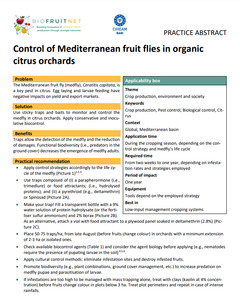{Tool} Control of Mediterranean fruit flies in organic citrus orchards (BIOFRUITNET Practice Abstract). Creator(s): Avosani, Sabina and Verrastro, Vincenzo. Issuing Organisation(s): CIHEAM Bari - Mediterranean Agronomic Institute of Bari. Biofruitnet Practice Abstract, no. 084. (2022)
|
PDF
- Published Version
- English
(Control of Mediterranean fruit flies in organic citrus orchards)
494kB | |
|
PDF
- Published Version
- Italian/Italiano
(Controllo della mosca della frutta mediterranea in agrumeti biologici)
496kB | |
![[thumbnail of 2023-04-21 18_31_27-Control of Mediterranean fruit flies in organic citrus orchards.png]](/44811/5.hassmallThumbnailVersion/2023-04-21%2018_31_27-Control%20of%20Mediterranean%20fruit%20flies%20in%20organic%20citrus%20orchards.png)  Preview |
Image (PNG)
- Cover Image
- English
109kB |
Document available online at: https://orgprints.org/44811
Summary in the original language of the document
Traps allow the detection of the medfly and the reduction of damages. Functional biodiversity (i.e., predators in the ground cover) decreases the emergence of medfly adults.
Practical recommendation
• Apply control strategies accordingly to the life cycle of the medfly (Picture 1).
• Use traps composed of (i) a parapherormone (i.e., trimedlure) or food attractants; (i.e., hydrolysed pro-teins); and (ii) a pyrethroid (e.g., deltamethrin) or Spinosad (Picture 2A).
• Make your trap! Fill a transparent bottle with a 9% water solution of protein hydrolysate (or the fertiliser sulfur ammonium) and 2% borax (Picture 2B). As an alternative, attach a vial with food attractant to a ply-wood panel soaked in deltamethrin (2.8%) (Picture 2C).
• Place 50-75 traps/ha, from late August (before fruits change colour) in orchards with a minimum extension of 2-3 ha or isolated ones.
• Check available biocontrol agents (Table 1) and consider the agent biology before applying (e.g., nema-todes require the presence of pupating larvae in the soil).
• Apply cultural control methods: eliminate infestation sites and destroy infested fruits.
• Promote biodiversity (e.g., plant combinations, ground cover management, etc.) to increase predation on medfly pupae and parasitisation of larvae.
• If infestations are too high to be managed with mass trapping alone, treat with clays (kaolin at 4% concen-tration) before fruits change colour in plots below 3 ha. Treat plot perimeters and repeat in case of intense rainfalls.
| EPrint Type: | Practice tool |
|---|---|
| What problem does the tool address?: | The Mediterranean fruit fly (medfly), Ceratitis capitata, is a key pest in citrus. Egg laying and larvae feeding have negative impacts on yield and export markets. |
| What solution does the tool offer?: | Use sticky traps and baits to monitor and control the medfly in citrus orchards. Apply conservative and inoculative biocontrol. |
| Country: | Italy |
| Type of Practice Tool: | Practice abstracts |
| Keywords: | Crop production, Pest control, Biological control, Citrus |
| Agrovoc keywords: | Language Value URI English crop production http://aims.fao.org/aos/agrovoc/c_5976 English pest control http://aims.fao.org/aos/agrovoc/c_5726 English biological control http://aims.fao.org/aos/agrovoc/c_918 English Citrus http://aims.fao.org/aos/agrovoc/c_1637 |
| Subjects: | Crop husbandry > Production systems > Fruit and berries Crop husbandry > Crop health, quality, protection |
| Research affiliation: | European Union > Horizon 2020 > Biofruitnet Italy > IAMB Mediterranean Agronomic Institute Bari European Union > Organic Farm Knowledge |
| Horizon Europe or H2020 Grant Agreement Number: | 862850 |
| Related Links: | https://organic-farmknowledge.org/tool/44811, https://biofruitnet.eu |
| Project ID: | ofk |
| Deposited By: | Basler, Andreas |
| ID Code: | 44811 |
| Deposited On: | 10 Dec 2022 17:35 |
| Last Modified: | 02 May 2024 10:31 |
| Document Language: | English, Italian/Italiano |
| Status: | Published |
Repository Staff Only: item control page

 Download Statistics
Download Statistics Download Statistics
Download Statistics
